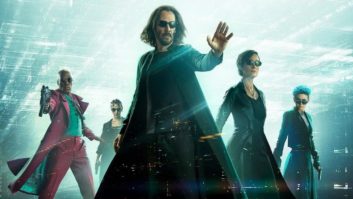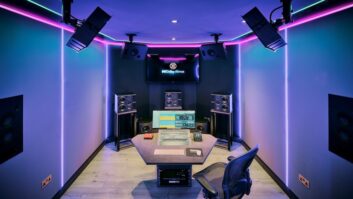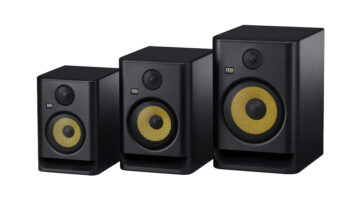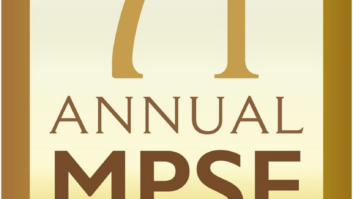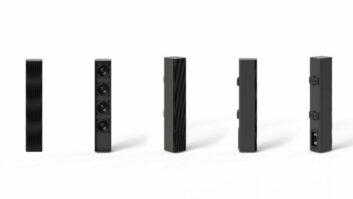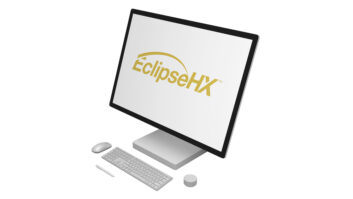With the out-of-the-box success of The Matrix, and its provocative soundtrack, it’s a given that sound designer Dane Davis and his company, Danetracks Inc., will no longer be any kind of industry secret.
The edgy, effects-laden feature-directed by the Wachowski brothers (whose directorial debut was the stylish Bound, also with sound design by Davis)-is a dazzling combination of traditional science fiction and new technology, and it provided Danetracks with budgetary and creative challenges that don’t come around very often.
From dripping computer code, alternative realities and machine monsters to kung fu, helicopters and even the sounds of silence, design for The Matrix ranged from classic to surreal.
Situated in West L.A., the Danetracks facility was formed in 1986 as a place for Davis to design elements for other sound editors. Davis, a supervising sound editor, re-recording mixer and sound designer with such smart movies as Drugstore Cowboy, Boogie Nights, Don Juan DeMarco, Romeo Is Bleeding, Your Friends and Neighbors and GO to his credit, began manipulating tape machines in high school. Recording pingpong games from the table leg’s perspective, taping backwards, turning reels by hand and running delay loops through the garage, he created soundtracks for his own Super 8 films. At the California Institute of the Arts film school, Davis honed his skills and learned studio engineering, tracking and mixing for his own films as well as other student projects. During a few postgrad years as a starving writer, he continued to create sound scores for short animated films and built up a client list of documentary, experimental and narrative feature filmmakers.
While not the biggest sound design house in town, Danetracks is extremely prolific. Part of what enables the staff to get so much done is their sophisticated communication system, which is unrivaled by much larger production houses.
“We did The Matrix with a very small crew considering how involved it was,” Davis explains. “About 12 people much of the time. It helps that we’re very heavily wired-all the Pro Tools, the Macs and the PCs are on the same Ethernet. We’ve been doing the wiring for this kind of thing in-house for the last ten years, pretty successfully, and then just recently we had a professional company come in and rewire everything from scratch.”
Danetracks uses a new server called Winframe on editorial databases, allowing onsite or offsite Macs or PCs to log into it. “That’s been terrific, because any of our Pro Tools stations can log into it directly and have it in the background. The servers all feed through the same wires, so there are some nice cross-pollinization possibilities,” Davis says. “Like on the stage [Warner Bros. Burbank’s Dubbing Stage 6, newly renovated and fitted with a Neve DFC console], with my little G3 Powerbook I can log into anything [at Danetracks] or onto any of our Pro Tools stations on other dubbing stages. I can get onto any drive or database and grab the audio files I need, or I can go directly into the library, find a sound, assign it to a spot and print it up for the transfer department. They put it on one of the servers, and I siphon it onto my stage drives. The system paid off hugely on this movie, saving a lot of freeway drive time.”
The Danetracks library now has more than 90,000 sound effects. Managing all that information is key. “It’s tricky, and we use a variety of databases,” Davis says. “Primarily we use the Leonardo Professional Librarian system. We’ve been evolving with the writer of it, Louis Benniof, forever-in fact, he made a bunch of big changes for us just before we started The Matrix. We’re able to track what every editor has cut, which is very important to me, because on most movies, I’ll literally pull all the sound effects and make very specific cutting sheets for the editors. But on this movie, I had Julia Evershade helping me with that, which was terrific. Julia’s a powerhouse; she knows my library really well, and I know hers.”
The highly wired aspects of Danetracks have permitted Davis to centralize a project yet allow people to work independently. “For example, we discovered early on with Pro Tools that by having cloned drives, copies of the actual audio that people are working with, the edit sessions can float independently,” Davis explains. “We can have three editors using the same audio in three different places and they can interchange their sessions. One person can be working on reel 3 effects and can log on and get the reel 2 effects edit session from another editor. It gives us a huge amount of freedom in terms of scheduling people and resources.”
One of Davis’ best editors moved to Austin, Texas, in the mid-’90s and now receives reels via FedEx, then posts the sessions back to the server over phone lines. “Since then, we have a bunch of editors working on their own satellite systems,” Davis says.
Upstairs at Danetracks is Davis’ sound design studio, fitted with a Sapphyre console (now primarily a monitoring matrix), a Westlake surround speaker system, and a full complement of outboard EQ and effects. It’s a full-service room; depending on the project, he can do sound design for specific scenes or dub a whole film.
“I try to find character and logic for all the sounds that the audience experiences,” he relates. “I’m always looking for some justification or explanation of what the characters are hearing and why the audience is hearing it. It’s usually pretty subtle, but it’s really important to me to be correct about this-the logic of sound effects.
“Some directors will spot very specifically,” he continues. “‘This person’s house is close to that kind of factory, and it clanks and clinks. That person lives next to the refinery, and it goes boom, boom, boom all day long until 5 o’clock when the whistle blows and it stops.’ That’s integrated into the story, and it becomes part of the environs those characters interact within. There can be a lot of nondirect human noises that become the character of a place. I have to run it by the test: ‘Are these sounds going to help propagate the story?’
“There actually have been times where I’ve stood up and said, ‘This would be a whole lot better without those sound effects!’ There are a lot of people who’ll fight for the effects to be as loud as possible at all times at any cost, and a lot of times those are the people who get all the attention because the audience is constantly aware of it. If your sound effects integrate seamlessly with the music, sometimes nobody notices them,” Davis explains. “I’ve had that happen to me hundreds of times, where I was being careful with the dubbing mixers to integrate the effects so that you didn’t notice when the score cues, or even source cues, were starting and stopping.”
A good example of that blend is the slow motion “gun ballet” scene in the government building lobby scene in The Matrix.
“We had to find a way to make the pulse of the source song come through,” Davis says. “It had been cut extremely carefully to fit the scene by Zig Gron, the source music editor, working with score editor Laurie Eschler. I had to dance around that music, and in some places it meant not hearing the guns-they’re just part of the fabric of it. We’d let that particular downbeat come in, let that particular bass guitar riff establish itself, and then the guns would come back in. A lot of times it’s not literal at all. We tried to play the characters’ mental perspective of all the sound events in the scene. In this case, it’s as if the song was pumping the characters up to their actions.”
The Matrix was a long time coming; Davis and the Wachowskis had talked about the film for three years before production began. It turned out to be a good thing that they had all those early conversations, because once the actual shooting began in Australia, there was little time for Davis to interact with the directors.
“It was a massive undertaking,” Davis laughs. “The directors had 500 people on the crew there, and all these visual effects people-they were busy all the time. It’s not like I could call them up and chat. We had very concise e-mail messages and certain key phone calls, then they had to just trust me and I had to trust my own instinct and understanding of their filmmaking. I’d create sequences of things, either with or without picture, that I would wire back to them as audio files. They’d load them in their Avid the next day, and I’d get some feedback. But even then it’s not like they had opportunities to just put my work up; it was just that the next time they worked on that scene it would have some of my stuff in it, and it either worked great, or it worked okay or it completely sucked, which luckily rarely happened.”
It helped that the film was storyboarded in exacting detail, a habit of the Wachowskis probably stemming from their comic book writing background. “They were masterpieces of storyboard, with all the angle changes and zooms,” Davis recalls. “We went through the entire storyboards a year or so before they started shooting, and that was instrumental because we never got much of a chance again.”
It also helped that Don Davis, music composer for The Matrix, had also scored Bound. “He’s not actually my brother,” Dane Davis laughs. “But we pretend he is. We discussed each scene as we evolved the score and sound design. So we both knew each other’s relative dynamics, density and important moments of needed clarity. I think all those conversations show in the fused and flowing quality of the total soundtrack.”
“Working on this movie was a field day,” Dane Davis concludes. “Really intense and complex. Zach Staenberg [editor on The Matrix and Bound] and I were talking before they started shooting it, and he said, ‘The goal here is to make a $70 million handcrafted movie, like Bound was a $4 million handcrafted movie.’ On Bound, every aspect was carefully sculpted and very few compromises were made. I think in the end that’s really what was also achieved on The Matrix.”
AfterThe Matrix was finished Davis went back to work on a project he’d begun long before, an independent film produced and directed by Matt Palmieri, featuring Harry Dean Stanton and Emilio Estevez, titled Sand. The soundtrack for Sand was unique in that it was posted completely in Pro Tools in Dolby Stereo using three six-voice systems slaved together by AES. All premixes were kept virtual with all source tracks readily available for changes if needed. Davis also did all equalization in Pro Tools, taking full advantage of the automation.
“Working this way allows me to be mixing in the present tense locked to picture, with the client listening, and at the same time to be mixing up ahead, or fixing something that just went by without stopping,” he says. “So, sometimes I’m literally mixing in the past, present and future simultaneously!”
At the same time he was finishing Sand, Davis was starting on the Joel Silver-produced House on Haunted Hill, set for a Halloween release. “Making scary noises is always the most fun,” he laughs. “We’re trying to bypass a lot of the usual stuff, though-the life of the house is mechanical, human and monstrous at the same time, which lends itself to a huge range of sounds.”
With both another “massive” movie, and another indie “little gem” in the works, Davis won’t find himself pigeonholed any time soon. His projects continue across the board in style, with the only continuing theme his constant forays into new technologies that will help him get the job done.
